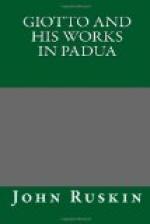[Footnote 21: See account of his principles above, p. 13, head C.]
* * * * *
XIX.
THE FLIGHT INTO EGYPT.
Giotto again shows, in his treatment of this subject, a juster understanding of the probable facts than most other painters. It becomes the almost universal habit of later artists to regard the flight as both sudden and secret, undertaken by Joseph and Mary, unattended, in the dawn of the morning, or “by night,” so soon as Joseph had awaked from sleep. (Matt. ii. 14.) Without a continuous miracle, which it is unnecessary in this case to suppose, such a lonely journey would have been nearly impracticable. Nor was instant flight necessary; for Herod’s order for the massacre could not be issued until he had been convinced, by the protracted absence of the Wise Men, that he was “mocked of them.” In all probability the exact nature and extent of the danger was revealed to Joseph; and he would make the necessary preparations for his journey with such speed as he could, and depart “by night” indeed, but not in the instant of awakening from his dream. The ordinary impression seems to have been received from the words of the Gospel of Infancy: “Go into Egypt as soon as the cock crows.” And the interest of the flight is rendered more thrilling, in late compositions, by the introduction of armed pursuers. Giotto has given a far more quiet, deliberate, and probable character to the whole scene, while he has fully marked the fact of divine protection and command in the figure of the guiding angel. Nor is the picture less interesting in its marked expression of the night. The figures are all distinctly seen, and there is no broad distribution of the gloom; but the vigorous blackness of the dress of the attendant who holds the bridle, and the scattered glitter of the lights on the Madonna’s robe, are enough to produce the required effect on the mind.
The figure of the Virgin is singularly dignified: the broad and severe curves traced by the hem and deepest folds of her dress materially conducing to the nobleness of the group. The Child is partly sustained by a band fastened round the Madonna’s neck. The quaint and delicate pattern on this band, together with that of the embroidered edges of the dress, is of great value in opposing and making more manifest the severe and grave outlines of the whole figure, whose impressiveness is also partly increased by the rise of the mountain just above it, like a tent. A vulgar composer would have moved this peak to the right or left, and lost its power.




